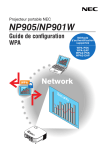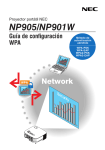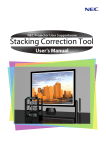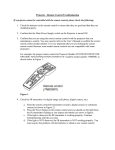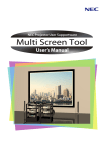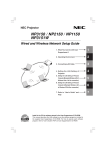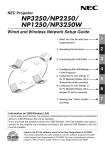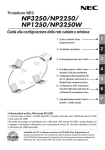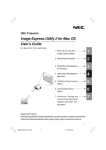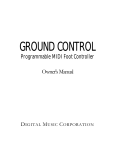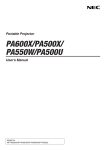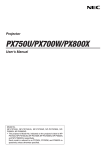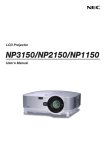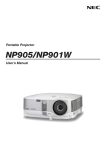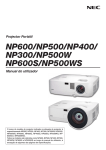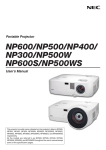Download 1. Installation of the Stacking Correction Tool
Transcript
NEC Projector User Supportware Stacking Correction Tool User’s Manual Introduction Thank you for using the Stacking Correction Tool. Please read this User's Manual carefully to aid in the proper use of this product before using the Stacking Correction Tool. • The Stacking Correction Tool is software that uses the [GEOMETRIC CORRECTION] function of the NEC projector to easily perform stacked projection. This manual mainly describes operations on NP3250 series projectors. Terminology In this manual, the term stacking correction is used to describe the following processes performed by the Stacking Correction Tool. 1. Photographing the projected images of multiple projectors with a digital camera or a web camera 2. Perform comparisons and calculations so that the content of the projected images is superimposed, and create the GEOMETRIC CORRECTION data 3. Send the [GEOMETRIC CORRECTION] data to each projector NOTE (1) Unauthorized reproduction of a part of or all of the content of this manual is prohibited. (2) The content of this manual is subject to change without notice. (3) Great care has been given to the creation of the content of this manual; however, should you notice any questionable points, errors, or omissions, please contact us. (4) Notwithstanding section (3), NEC will not bear any responsibility for claims due to loss, lost profit, or other matters for reason of the use of this software. 2 Precautions in Projector Installation • Please pay attention to the installation so that the positioning of the ventilation outlet and the ventilation inlet of adjacent projectors is not too close. A projector taking in the exhaust of an adjacent projector will result in overheating or other faults. • Do not physically stack projectors one above the other. Projectors that are physically stacked could fall causing damage and breakdown of the projectors. Installation Example Using 2 Projectors In consideration of using this software, we recommend an installation like the following when the installation combines 2 projectors. Installation Examples Left side Front Ventilation outlet Exhaust Cabinet Warning Note Right side Ventilation inlet Intake Cabinet Cabinet • Please request ceiling mount and other special installation at your store of purchase. Installation should never be undertaken by the customer. Doing so could result in the projectors falling or in injury. A strong cabinet that will support the weight of the projectors should be used in this installation. Do not stack the projectors directly one upon the other. • Please see the user's manual of the projector for information about the range of projection distance. • Leave sufficient space to the left and right of the projectors so that there is no obstruction of projector air intake and exhaust. Obstruction of air intake and exhaust will result in a rise of the internal temperature of the projector and will cause breakdown. Please read the projector User's Manual for other installation precautions. 3 Restrictions on Projectors that Are to Be Installed • Install all projectors on the same network. • Set all projectors to the same resolution. • Use the same model to the extent possible. * When there is a difference in the brightness of the projectors, the digital camera or web camera might not accurately read the projection image at the time of calibration. * There will also be a difference in brightness depending on the setting of the [LAMP MODE]; therefore, set the [LAMP MODE] to a uniform setting of either [NORMAL] or [ECO] for the projectors that are being installed. * Please note that use of models in different lineups, such as an NP3250 series model with a model in the NP-PA600 series, is not supported. The projected images may shift out of position when the mouse pointer is moved or when playing animated images. • Please note that the use of this software for [DESKTOP REAR] and [CEILING REAR] projector projection methods is not supported. Application Environment of the Stacking Correction Tool The following personal computer environment is recommended to provide convenient use of digital cameras or web cameras when calibrating. Windows 7/Windows Vista Windows XP Pentium 4, 2.4 GHz (A processor of 2.8 GHz or higher is rec- Pentium 4, 1.4 GHz, or AMD Athlon 1 GHz (A Pentium 4, 2.4 ommended) GHZ processor or higher is recommended) 512 MB RAM (1 GB or greater is recommended) 128 MB RAM (256 MB or greater is recommended) 1 GB or more of free hard disk space 1 GB or more of free hard disk space Note Use of the Stacking Correction Tool should be performed by an "Administrator" for Windows 7/Windows Vista, and a "Computer Administrator" for Windows XP. Required Components .NET Framework 3.5 DirectX 9 Java (Version 6, update 10 or later) Supported Equipment Projector*¹*² NP3250 / NP2250 / NP1250 / NP3250W NP-PA600X / NP-PA500X / NP-PA550W / NP-PA500U NP-PX750U Digital camera Canon EOS Rebel XTi (in North America) Canon EOS Rebel XSi (in North America) Canon EOS Rebel T1i (in North America) Canon EOS 400D (in Germany) Canon EOS 450D (in Germany) Web camera Logitech® QuickCam ® Pro 9000 Logitech® QuickCam ® Pro for Notebooks Logitech® Webcam Pro 9000 Logitech® Webcam C600 *¹An NP905 series (NP905/NP901W) or NP3150 series (NP3151W/NP3150/NP2150/NP1150) projector can be used as the master projector ( page 12). (Only NP3250 series projectors can be used as the projector for stacking correction.) *²It is not possible to use projectors with different resolutions simultaneously. Use projectors with the same resolution. Supported Screens Only flat screens are supported. Curved screens are not supported. Note also that proper calibration might not be possible for rear projection screens and other screens in which there is a large difference in brightness between the center and peripheral areas. 4 Steps up to Stacking Correction Install the Stacking Correction Tool Page 7 Install and connect the computer, projector, digital camera, or web camera Setup the Stacking Correction Tool Page 15 Make adjustments to the projector, digital camera, or web camera Projector preparation Digital camera or web camera preparation Perform the Stacking Correction Page 19 Page 21 5 Page 20 Page 11 Table of Contents Precautions in Projector Installation.............................................................................. 3 Installation Example Using 2 Projectors...................................................................... 3 Restrictions on Projectors that Are to Be Installed. ................................................. 4 Application Environment of the Stacking Correction Tool..................................... 4 Windows 7/Windows Vista............................................................................................. 4 Windows XP..................................................................................................................... 4 Required Components. .................................................................................................. 4 Supported Equipment..................................................................................................... 4 Supported Screens......................................................................................................... 4 Steps up to Stacking Correction..................................................................................... 5 1. Installation of the Stacking Correction Tool ........................................................... 7 Installing the Stacking Correction Tool.............................................................................. 7 Uninstallation of the Stacking Correction Tool................................................................10 Windows 7/Windows Vista............................................................................................10 Windows XP....................................................................................................................10 2. Installation and Connection of Equipment.............................................................11 Connections for Stacking Correction................................................................................11 To perform stacking correction with LAN connections only.....................................11 To perform stacking correction using the display output terminal...........................12 Connections for Projecting an Image...............................................................................13 RGB Signal. ....................................................................................................................13 Component Signal. ........................................................................................................14 S-video signal.................................................................................................................14 3. Stacking Correction Tool Settings. ...........................................................................15 Starting the Stacking Correction Tool . ............................................................................15 Names of the Stacking Correction Tool Screen..............................................................15 Stacking Correction Tool Menu.........................................................................................16 Names of the Calibration Screen......................................................................................17 4. Preparation of the Projectors......................................................................................19 5. Preparation of the Digital Camera or Web Camera. .......................................... 20 6. Performing Stacking Correction................................................................................21 7. Calibration..........................................................................................................................24 Cautions when using the display output connector....................................................... 25 8. List of Error Messages. ................................................................................................ 27 6 1. Installation of the Stacking Correction Tool Preparation: Save the downloaded Stacking Correction Tool file to the desired location * The same installation procedure is used for Windows 7/Windows Vista and Windows XP. Installing the Stacking Correction Tool 1. Double click SCTxxx.exe The installation screen will be displayed. Note Java (version 6, update 10 or later) and .NET Framework 3.5 are required in the use of the Stacking Correction Tool. If these terms have not been satisfied, the screen to the right will be displayed when starting SCTxxx. exe. When [Install] is selected, a connection will be made with the Internet and downloading of the required component files from the distribution source site will begin. When the download is completed, the setup program will start automatically. Follow the instructions on the screen and complete the setup. Java Installation Screen * When making a new installation of .NET Framework 3.5 on Windows XP (i.e., an older version of .NET Framework has not been installed), the required component files will have a size of about 63 MB (and about 20 MB when using Windows Vista). It could take a considerable time from the start of downloading to the completion of installation. Also, if requested to restart Windows after installing .NET Framework 3.5, please follow the instructions and restart Windows. The installation of the Stacking Correction Tool will continue after restarting Windows. * If connection cannot be made with the Internet, use another computer that can connect with the Internet and access the URL listed below, then download the required component files and use them. [Java] http://www.java.com/en/ [.NET Framework 3.5] http://msdn.microsoft.com/en-us/netframework/default.aspx 7 .NET Framework 3.5 Installation Screen 1. Installation of the Stacking Correction Tool 2. Select "I accept the terms in the license agreement" and click [Next]. Please read the content of the END USER LICENSE AGREEMENT carefully. A screen for verifying the installation location will be displayed. 3. Click [Next] To change the installation location, click [Change] and specify the installation location. A screen notifying that the installation preparation has been completed will be displayed. 4. Click [Install] The installation will begin. As the installation proceeds, installation will start for applications required in the operation of the Stacking Correction Tool. 5. Click [OK] A screen for verifying the installation location will be displayed. Note If a language selection screen is displayed, select the language and click [OK]. 8 1. Installation of the Stacking Correction Tool 6. Click [Install] The installation will start. To change the installation location, click [Browse…] and specify the installation location. Note DirectX 9 or later is required in the use of this application. If these terms have not been satisfied, the screen to the right will be displayed. Follow the instructions on the screen and complete the setup of DirectX Installation Screen DirectX 9. 7. Click [Close] This completes the installation of the Stacking Correction Tool. Click [Finish] on the screen and close the setup program. 9 1. Installation of the Stacking Correction Tool Uninstallation of the Stacking Correction Tool Windows 7/Windows Vista Select the Stacking Correction Tool from [Uninstall a program] under [Control Panel] and uninstall it. Windows XP Select the Stacking Correction Tool from [Add/Remove Programs] under [Control Panel] and uninstall it. 10 2. Installation and Connection of Equipment Connections for Stacking Correction To perform stacking correction with LAN connections only See page 4 for projectors supporting stacking correction. LAN Projector Projector Digital camera WIRELESS NP3250 series Web camera WIRELESS WIRELESS COMPUTER1 IN LAN COMPUTER1 IN or To digital connector NP3250 series To USB port NP3250 series To LAN port Computer (for stacking correction) Note Projector WIRELESS LAN • Install the digital camera or web camera facing the projection image. • The photographic coverage of the digital camera or web camera is 30˚. • Plug each projector into a power outlet. • Connect each of the projectors to the same network. • Use LAN cable that supports Category 5 or higher for the connection to the network. 11 2. Installation and Connection of Equipment To perform stacking correction using the display output terminal Only the NP905 and NP3150 series projectors support connection to the display output terminal. Also, only the NP3250 series projectors support stacking correction. LAN Projector LAN COMPUTER/COMPONENT 1 IN Digital camera Projector Web camera WIRELESS WIRELESS Projector or NP3250 series To digital connector NP905 series NP3250 series To display output connector To USB port To LAN port Computer (for stacking correction) Connect the projector to the computer's display output terminal, then on the Stacking Correction Tool, select [Display Output Connector] under [Calibration Mode] → [Master Projector] ( page 15). * For the NP905 and NP3150 series, there is no need to connect the projectors to the LAN. Note • Install the digital camera or web camera facing the projection image. • The photographic coverage of the digital camera or web camera is 30˚. • Plug each projector into a power outlet. • Set the computer's display resolution to match the resolution of the projector for stacking correction (NP3250 series). Correction cannot be performed properly if the resolutions are different. • Set the projected image of the projector connected to the display output terminal to the same display as the computer's primary display (dual view). (Correction is not possible using an extended desktop view.) • When the projector is connected to the display output terminal and calibration starts, the test pattern being adjusted is also displayed on the computer's primary display. * Press the ESC key on the keyboard to cancel calibration. * Cautions when calibrating with the projector connected to the display output connector ( 12 page 25) 2. Installation and Connection of Equipment Connections for Projecting an Image RGB Signal COMPUTER1 IN COMPUTER1 IN WIRELESS WIRELESS WIRELESS WIRELESS WIRELESS WIRELESS COMPUTER1 IN Projector Projector Projector VGA signal cable VGA signal cable 1 2 3 Analog RGB output Analog RGB input Analog RGB signal divider (Mini D-Sub 15 pin) Computer To displayed output connector (Mini D-Sub 15 pin) VGA signal cable Note • When the projectors are connected with a daisy chain connection, the RGB video signal will be attenuated and its projection might not be possible. Use an RGB signal divider as illustrated in the above connection diagram. Daisy Chain Connection COMPUTER1 IN MONITOR OUT COMPUTER1 IN MONITOR OUT To Computer 1 input of the next projector RGB output connector of PC Reference • Connections can also be made using commercially available BNC cable. 13 2. Installation and Connection of Equipment Make connections as illustrated in the diagrams below when connecting video equipment other than the computer (e.g., DVD players, S-video, etc.). Component Signal COMPONENT IN COMPONENT IN Projector COMPONENT IN Projector Projector Component video cable Component video cable Y DVD component signal divider Cb Cr Output1 Y Cb Cr Output2 Y Cb Cr Output3 Input Y Cb Cr Component video cable L Y R Cb Cr Audio output Component output DVD player S-video signal S-VIDEO IN S-VIDEO IN Projector S-VIDEO IN Projector Projector S-video cable S-video cable S-video cable 1 S-video signal divider 2 3 S-video output S-video input S-video cable L R Audio output VIDEO S-VIDEO Video output DVD player / Video deck Reference • Connections can also be made via network using Image Express Utility 2.0. 14 3. Stacking Correction Tool Settings Starting the Stacking Correction Tool The same Stacking Correction Tool starting method is used for Windows 7/Windows Vista and Windows XP. Select the Stacking Correction Tool from [Start] → [All Programs] → [NEC Projector User Supportware] and start it. Names of the Stacking Correction Tool Screen Stacking Correction Tool Main Screen ❶ ❷ ❸ ❹ ❺ ❶ List of Connected Projectors Displays the connection order, IP address, projector name, and resolution for the currently connected projectors. ❷ Destination of Geometric Cor- Select settings 1 to 3 of the projector's [GEOMETRIC CORRECTION] onscreen menu as rection Data the [GEOMETRIC CORRECTION] data storage location after stacking correction. ❸ Calibration Mode Master Projector: The projector that will serve as the master is determined, and the projection image of another projector undergoes stacking correction so that it is in agreement with the projection image of the master projector. In this instance, the [GEOMETRIC CORRECTION] of the master projector does not change. When [Display Output Connector] was selected, the projector connected to the computer's display output terminal is set as the master projector. Auto: When there is a screen frame, the projection image is corrected so as to fit inside that frame. When there is no frame, correction is applied so that the area of the rectangle is maximized within the superimposed portion of the projection area. The aspect ratio of the input signal is not maintained at this time. ❹ [Next] Display the calibration screen. ( ❺ [Exit] Closes the Stacking Correction Tool. 15 Page 17) 3. Stacking Correction Tool Settings Stacking Correction Tool Menu File Open This opens the GCXS file (with .gcxs extension) that was saved with [Save as] and sends the [GEOMETRIC CORRECTION] data to each of the connected projectors. When using a GCXS file to reproduce a projection that has undergone stacking correction, the installation and connection condition of each projector must be the same as when the GCXS file was saved. When there has been a change of the projector connection order, installation position, projection angle (including tilt foot adjustment), projection position (including lens shift adjustment), or other settings, projection that has undergone stacking correction cannot be reproduced. Save as *can be selected w h e n stac k in g correction is completed This gathers the [GEOMETRIC CORRECTION] data, and the connection order of each projector and saves it as stacking correction data (in a GCXS file). Exit Closes the Stacking Correction Tool. Options The projectors that will be used in stacking correction are selected with this screen. Select the type of network (type of NIC: network interface card) with the topmost pull-down menu. Connect Detects a projector that is connected to the network and displays it on a list. Update Updates the list display when there has been an increase or decrease of the number of network projectors, when there has been a change in the type of projector, or some other change. Input Address Specifies and searches the IP address of the projector. The search method can be selected from the following two types. • Direct input and searching of the projector IP address • Specification and searching of a range with start address and end address Edit List Specifies an address and registers on a list the projectors that have been searched. This also permits post registration editing and deletion, and additions and searches by address specification. Communication Settings Camera Setting Selects the type of camera. To connect QuickCam® Pro for Notebooks, select [Logitech2]. Geometric Correction Changes the geometric correction settings of the projector. Help This displays the help file of the Stacking Correction Tool. About Displays the version of the Stacking Correction Tool. Help 16 3. Stacking Correction Tool Settings Names of the Calibration Screen Calibration Screen ❶ ❷ ❸ ❹ Starts the stacking correction ❶ Start Calibration *When using a web camera, clicking [Start Calibration] will start the utility software of the web camera. ❷ Camera Setup Performs the angle of view check and other camera checks. ❸ Quit Discontinues the correction and returns to the Stacking Correction Tool. ❹ Calibration Progress Displays the progress of the calibration as a percentage. 17 3. Stacking Correction Tool Settings Camera Setup Screen ❺ ❶ ❷ ❼ ❸ ❹ ❻ ❽ Depending on the camera, items marked with C might not function. ❶ Take Another Picture Takes a photograph. ❷ Gain C Adjusts the gain of the digital camera. ❸ Current ISO Speed C Changes the ISO speed of the digital camera. ❹ Current Resolution C Adjusts the resolution of the digital camera. ❺ Show Test Pattern on Projector ❻ Zoom Out/Zoom In C Sends a (15 x 15 dot) test pattern to the projector of the specified number. The number of connected projectors is displayed. (Maximum of 4.) Adjusts the zoom of the digital camera. The photographs that have been taken will be displayed. Note Either when using a digital camera or a web camera, set up so that the projection image fits this preview screen. Even though the projection image fits the preview screen of the utility software supplied with the web camera, the projection image might extend beyond the photographic range in the [Camera Setup] preview ❼ Preview Screen screen. If this occurs, adjust the position or angle of the web camera, take a photograph with [Take Another Picture], and perform the setup while checking. When using a digital camera, the results of adjusting the gain, shutter speed, resolution, and zoom will be photographed automatically, and will be displayed on the preview screen. ❽ Finish Closes the Camera Setup. 18 4. Preparation of the Projectors The projectors used in the stacking correction will now be prepared. Please refer to the user's manual of the projector in conjunction with the description given in this manual. 1. Install and connect the projectors that will be used, and project them onto the screen (The portion of projectors that will be used) Connection of the Equipment Page 11 2. Adjust the Projectors Refer to the projector user's manual and perform the following adjustments. • Adjust so that the projection image of each projector enters the screen. • Set [LAMP MODE] to the same setting for each of the projectors. • Make image quality adjustments, projection position adjustments, and zoom and focus adjustments as required. • When performing the stacking correction in conjunction with the projection screen of the master projector, perform the [CORNERSTONE] adjustment for the projector that will be the master. If the projection image of the master projector is distorted, stacking correction will be also performed for the other projectors in conjunction with the distorted projection image. * When there has been a selection of [By detecting the most extreme corners] (i.e., stacking correction at the maximum allowable size), the [CORNERSTONE] setting of all of the projectors will be reset and there will be no need to make the setting. Note • The [CORNERSTONE] screen will not be displayed when making adjustments with the [KEYSTONE] screen, or when setting [GEOMETRIC CORRECTION]. To perform the [CORNERSTONE] adjustment, hold down the 3D REFORM button for 2 seconds or longer, and clear the [KEYSTONE] adjustment values. Likewise, the [KEYSTONE] screen will not be displayed when making adjustments with the [CORNERSTONE] screen, or when setting [GEOMETRIC CORRECTION]. To perform the [KEYSTONE] adjustment, hold down the 3D REFORM button for 2 seconds or longer, and clear the [CORNERSTONE] adjustment values. Reference • When making settings on a number of projectors, it will be convenient to use the optional remote control (NP02RC). Using the projector [CONTROL ID] function, one optional remote control will permit the operation of individual projectors, or the operation of all projectors at once. Please see the projector user's manual for information about the [CONTROL ID] setting. • Setting a [PROJECTOR NAME] to a projector in advance will aid in recognition even in the list displayed in the Stacking Correction Tool [Communication Settings], and will be convenient at the time of installation. Please see the projector user's manual for information about the [PROJECTOR NAME] setting. 19 5. Preparation of the Digital Camera or Web Camera The digital camera or web camera used in the stacking correction will now be prepared. Please refer to the user's manual of the digital camera or web camera in conjunction with the description given in this manual. 1. Perform Settings of the Digital Camera or Web Camera that Will Be Used Optimal camera settings will be made for the stacking correction. Set the digital camera or web camera as described below. Digital Camera Setting Item Selection Notes Select M (Manual exposure) from among the five applicable Mode dial on the digital camera body M exposure modes of A-DEP (automatic depth of field priority AE), M (manual exposure), Av (aperture priority AE), Tv (shutter priority AE), and P (program AE). Focus mode switch on the digital MF camera body Stabilizer switch on the digital cam- OFF era body Select MF (manual focus) from among the two modes of AF (automatic focus) and MF (manual focus). Set the stabilizer switch to OFF. Web Camera Install the utility software that comes with the web camera and after startup, perform the settings as described below. Setting Item Webcam Focus* Settings White Balance RightLight™ Settings Advanced Settings Selection [Manual Focus] Manual Automatic Right- Off Light™ Settings Exposure/Gain Manual Anti Flicker [Off] Notes Change to [Manual Focus] when [Auto Focus] is selected. Uncheck the "Auto" check mark. Select [Do not use automatic RightLight settings]. Uncheck the "Use Automatic Settings" check mark. Select Off from among Off, 50 Hz (Europe), and 60 Hz (North America). * There is no [Focus] setting item when using models with no auto focus function. * The terminology used here is for the web camera's utility software version 1.10. Terms may differ with other versions. 2. Make a Connection to the Computer Using the USB Cable Connection of the Equipment Page 11 * Use the USB connection cable that comes with the digital camera or the web camera. To the USB port of the computer 20 6. Performing Stacking Correction The stacking correction will be performed after completion of the connections of the projectors, digital camera or web camera, and the computer. 1. Start the Stacking Correction Tool 2. Select the Projectors Select [Communication Settings] of the [Options] menu, then ❶ select the network type, ❷ enter a check mark for the projectors that will be used, click [Connect], and add to the list. * Up to a maximum of 4 projectors can be used in stacking correction. ❶ ❷ 3. Select the Camera Select the camera type with [Camera Setting] under [Options]. 4. Select the [GEOMETRIC CORRECTION] data storage location The default setting is [1]. Note In the projector, GEOMETRIC CORRECTION data has already been registered in 1 to 3 as the default setting. The existing GEOMETRIC CORRECTION data of the selected number will be overwritten in the saving location by the Stacking Correction Tool. 21 6. Performing Stacking Correction 5. Select the Type of Stacking Correction * When the master projector has been determined and stacking correction is going to be performed, this setting selects which projector in the group will be made the master. Reference • When [Display Output Connector] was selected, the projector connected to the computer's display output terminal is set as the master projector. When [Display Output Connector] was selected, switch the master projector's input signal to the computer. 6. Click [Next] The calibration screen will be displayed. Click [Camera Setup] and perform the camera adjustments. ( Page 18, 26) When the web camera is connected, perform the required settings with the utility software that came with the web camera. ( Page 26) 7. Click [Start Calibration] Calibration will start. Four types of test image (illustrated below) will be projected onto the screen in order. Note • During the calibration, please pay attention to the following points: - Do not touch the installation platform of the camera or projector. - Do not cut across in front of the camera. - Do not let shadows from outside light fall upon the screen. • Press the ESC key on the keyboard to cancel calibration. • Cautions when calibrating with the projector connected to the display output connector ( page 25) First: Completely black image Second: Completely white image Third: Image of dots (Five dots at screen center) Fourth: Image of dots (Screen full of dots) 22 6. Performing Stacking Correction Test images for the number of projectors connected will be sent and projected. * Screens on which test images are projected will be photographed by digital camera or web camera, and will be used as data for the calculation of stacking correction. When an error message is displayed at the time of sending the test image, and calibration cannot be completed, please see "Calibration" ( Page 24), and "Error Message List" ( Page 27). There will be a return to the Stacking Correction Tool screen upon completion of the calibration. 8. Click [OK] When [Display Output Connector] was selected, switch the master projector's input signal if necessary after stacking correction is completed. This completes the stacking correction. Note • When GEOMETRIC CORRECTION is set, KEYSTONE and CORNERSTONE cannot be selected. • Hold down the 3D REFORM button for 2 seconds or longer to clear the GEOMETRIC CORRECTION data that has been set. • GEOMETRIC CORRECTION performs an electrical correction and as such there may be a resultant drop in brightness or deterioration of picture quality. • Exceeding the limits of the correction or other factors may result in distortion of the picture or correction not being applied at all. Reference • After correction, fine adjustment is permitted with lens shift or lens zoom focusing. • Changes of conditions following installation and other factors may result in a shift of the image on the screen. Regular use of stacking correction will maintain the accuracy. 23 7. Calibration In calibration, differences in brightness on the screen are identified and calculations are performed. Also, for the purpose of the calculations, the contour of the projection image, and the position and shape of the test image are photographed with a digital camera or a web camera. If an error message is displayed during the calibration, first check the items listed below. Item to Check Cause and Action to Take Has the resolution of each of the projectors been adjusted? It is not possible to use projectors with different resolutions simultaneously. Use projectors with the same resolution. Has the brightness of each of the projectors been adjusted? To the extent possible, use the same model of projector in the stacking correction. When there is a difference in brightness between projectors, recognition of the contour or the position and form of the test image may not be possible with one of the projection images. Note also that a difference in brightness may arise from a difference of the setting of the projector LAMP MODE; therefore, each projector should be set to the same setting. See the projector user's manual for information about the LAMP MODE setting. Is the digital camera or web camera compatible with the Stacking Correction Tool? Please use a model that is supported by the Stacking Correction Tool as listed on Page 4. Note also that even though a supported model is used, please check whether the model is properly selected with [Camera Setting] under [Options]. ( Is the digital camera or web camera set as specified by the Stacking Correction Tool? Is the entire screen gathered within the photographic range of the digital camera or web camera? Page 16, 21) When the automatic adjustment function of the digital camera or web camera is enabled, an error may occur during calibration. Please set the digital camera or web camera as described on Page 20. Make adjustments so that the overall projection image can be photographed as large as possible; for example, move the setup position of the digital camera or web camera, or use the zoom function. * When using the web camera, even when the entire projection image is gathered within the photographic range in the supplied utility software preview screen, the projection image might be shifted outside of the photographic range in the [Camera Setup] preview screen. If this happens, it will not be possible to complete stacking correction (and a message will be displayed to move the camera). If the image size can be changed on your utility software, change the setting so that the image is the same size as the photographic range at [Camera Setup]. Preview Screen of the Web Camera Utility Software Yes No 24 [Camera Setup] Preview Screen Cautions when using the display output connector Be careful of the following when calibrating with the projector connected to the display output connector: - To turn off the projector's image in order to check the camera setup screen, use the projector's remote controller. - Before starting calibration, check the projector's input connector and the image mute mode, and check that the computer's screen is displayed. - If the on-screen menu of the projector connected to the display output connector is displayed, set so that it is not displayed. - Make sure that nothing other than the test pattern is displayed on the computer's screen while calibration is being performed. If the camera utility or other screen is displayed, either set so that it is not displayed or minimize it. 25 7. Calibration After checking the items on the previous pages, if an error still occurs during calibration, it is possible that the quality of the image photographed by the digital camera or web camera is insufficient and cannot be recognized. Please pay attention to the points described below and make adjustments of the photographic image using the camera setup screen or the utility of the web camera, then try the calibration. • Set a higher resolution of the camera. • Perform the gain adjustment while observing the preview screen. • Set up and adjust the camera so that the background of the screen (e.g., walls, etc.) does not enter the photographic range of the camera. When there is a difference in brightness between the screen and the background, an error may occur during calibration. Camera Adjustment Examples [Camera Preview Screen] Aim at the right image and adjust the camera so that the difference in brightness between the test image and the screen becomes distinct. Completion of calibration may not be possible in situations such as the following. Photographic Screen is too Bright Adjust the gain and the exposure. Note Extraneous Light Enters the Photo- The Contour of the Projected Image Falls Out- graphic Range side of the Photographic Range Use the camera zoom function, or Adjust the installation position of the adjust the installation position so that camera so that the contour of the pro- extraneous light does not enter the jection image fits into the photographic photographic range. range. If the adjustment values are not reflected after adjustments are performed with the web camera's utility software, close the "Calibration" and "Camera Setup" screens, then perform the web camera adjustments. 26 8. List of Error Messages When an error occurs during the calibration and a message is displayed, please refer to the table below and respond as indicated. Reference • Error messages extract a portion of the display content. • Rarely, an error message that is not listed in this manual may be displayed. If this happens, check the photographic image of the camera or the adjustment and position of the camera according to the error message. Error Message Cause of Error Response to Error The projection image does not fall within the photographic range of the camera. • Make adjustments so that the overall projection image can be photographed as large as possible; for example, move the setup position of the digital camera or web camera, or use the zoom function. The brightness at the periphery is low, and the test pattern cannot be detected. • Check the photographic image of the camera, adjust the gain and other settings, and check the difference in brightness between the test pattern and the background. Also, darken the peripheral illumination as much as possible. Unable to find a usable camera. and No Camera Found. The camera that was specified with the camera settings cannot be found. • Check that the model has been correctly selected with [Camera Setting] under [Options]. Could not initialize the Canon camera. The camera that was specified with the camera settings cannot be found. • Check the connections of the camera power supply and USB cable. • Check that the model has been correctly selected with [Camera Setting] under [Options]. Camera Initialization Error Camera initialization error • When calibration is performed with the preview screen started on the utility software of the web camera, the projection image of the test pattern cannot be photographed with [Calibration Screen] of the Stacking Correction Tool. Close the preview screen of the utility software and perform the calibration again. Too many spots found. and Too few spots found. The correction points cannot be properly detected from the test pattern. • Check the photographic image of the camera, adjust the gain and other settings, and check the difference in brightness between the test pattern and the background. Also, darken the peripheral illumination as much as possible. The programmer called a function that is not implemented. A function not supported by the camera was used. • Press the [Dismiss] button and return to the original screen. Maximum value reached, cannot increase more and Minimum value reached, cannot decrease more The maximum value or the minimum value of the adjustment range has been reached. • Press the [Dismiss] button and return to the original screen. The region found seems to use a very small using roughly xx by yy pixels in the camera. A n a p p r o p r i ate p h o t o g r a p h i c range cannot be detected. • Check whether the screen has become too bright from outside light striking it. • Check the photographic image of the camera, adjust the gain and other settings, and check the difference in brightness between the test pattern and the background. Also, darken the peripheral illumination as much as possible. Found Maximum Colors of (rrr, ggg, bbb) with a highest possible value of 255. There is insufficient brightness and the test pattern cannot be detected. • Check the photographic image of the camera, adjust the gain and other settings, and check the difference in brightness between the test pattern and the background. Also, darken the peripheral illumination as much as possible. Error Writing Image NEC Projector: (IP address) There is an error in communication with the projector. • Check the condition and connections of the projector, and perform the calibration again. Unable to find a grid from the spots. The correction points cannot be properly detected from the test pattern. • Check the photographic image of the camera, and adjust the camera or move the camera position so that the entire test pattern can be read. Also, darken the peripheral illumination as much as possible. Insufficient Camera Contrast. The contrast is insufficient. • Check whether the screen has become too bright from outside light striking it. Please move the camera. The projector is not entirely in view. 27 Trademarks • Microsoft, Windows, Windows Vista, .NET Framework, and DirectX are either registered trademarks or trademarks of Microsoft Corporation in the United States and other countries. • Java is a registered trademark of Sun Microsystems, Inc. in the United States and other countries. • Powered by Scalable Display Technologies Protected by US Patent 6,456,339 and patents pending • Canon and EOS are registered trademarks of Canon Inc. • Logitech and QuickCam ® are trademarks or registered trademarks of Logitech Inc. © NEC Display Solutions, Ltd. 2009 - 2011 Ver.4 08/11 28





























